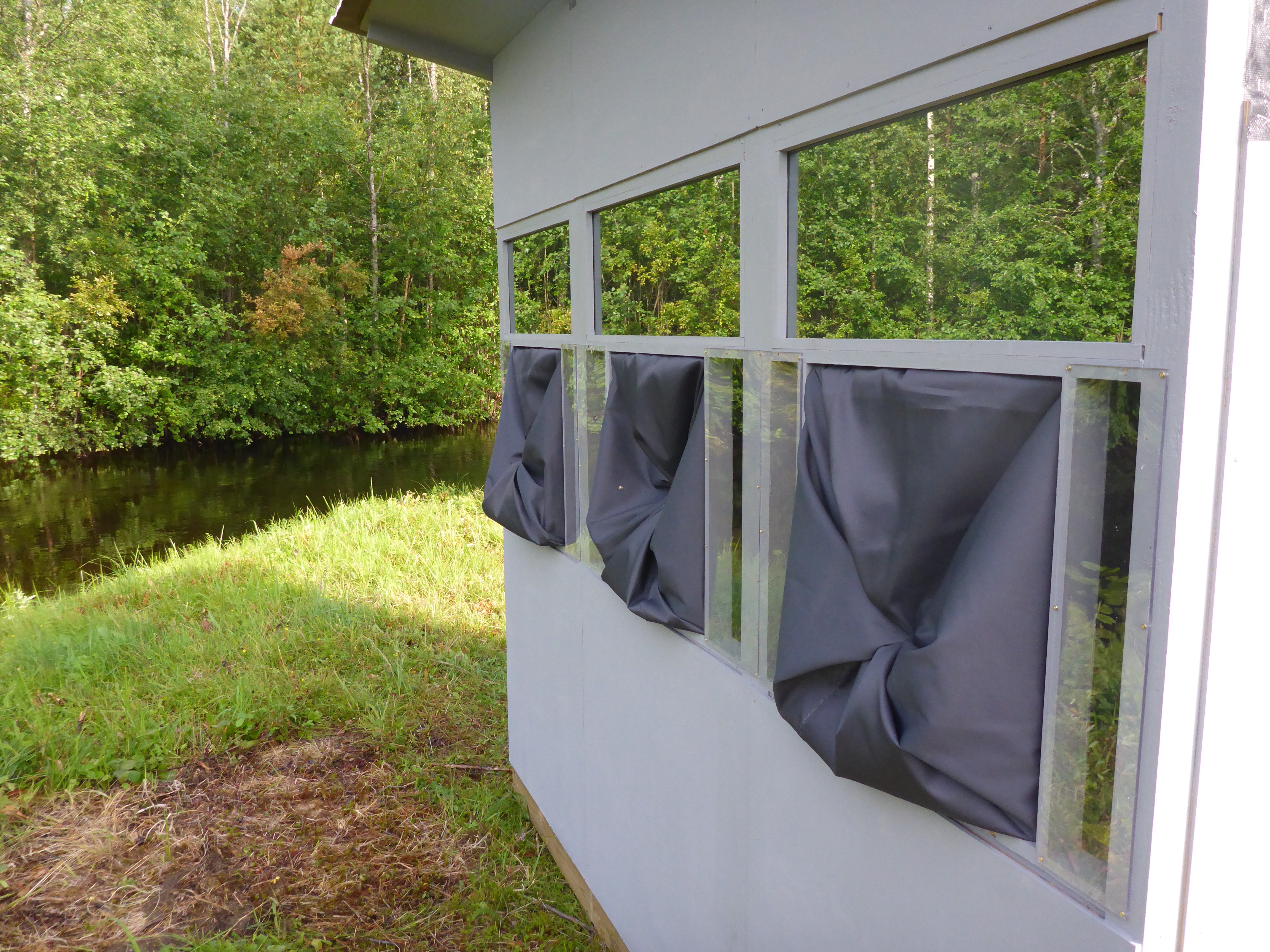Photography hides
Osprey Oasis' hides are placed around the pond, taking into account the needs of both photographers and ospreys. As a neutral dark gray, they blend in well with the environment. The ospreys can strike and exit freely between them, offering great opportunities for spectacular pictures.

The hides have comfortable, height-adjustable chairs and large mirror glass or anti-reflection windows, so ospreys can't strike unexpectedly. In addition, ospreys cannot see the photographer's movements inside the hide.
The light-built hides are also designed with the interior in mind for photographing and observing ospreys. They have standing height and the shooting apertures are at just the right height. Two hides (Aquila and Pandion) also have one low-angle opening right at ground level for photographers with acrobatic skills.
The hides have one shooting opening per photographer. If not all filming locations in the hide are in use, the customer can use several filming locations at the same time.
Filming equipment is attached to the photographers' own ball or liquid heads, which in turn are screwed onto a heavy metal plate on a wide plane. In this way, the camera and lenses can be moved and fine-tuned freely in the lateral and depth directions. A tripod cannot be used in the hides.
The storage spaces in the hides are limited, so photographers are expected to bring only the most necessary equipment. The most suitable lens has a focal length of 300-400 mm. Lenses longer than this can in some situations be suitable for close-ups, but even without a super telephoto lens you can do just fine in the oasis.
Aquila
Aquila is one of Osprey Oasis's most popular hides. First-time visitors should start getting acquainted with the oasis's possibilities from this hide, as you can see well what's happening around. Often ospreys dive straight towards and rise on their wings towards the hide. The hide has good space for two people, but three can also fit for photography. Additionally, the hide has one low-angle opening. The shooting direction is to the west, which often means beautiful backlighting in the evenings. A suitable focal length for the lens is 300mm, but you can of course use longer lenses for close-ups. Aquila can be reserved separately for either morning or evening sessions, and for a full day if needed. You cannot stay overnight in the hide.
Etus
The three-person Etus offers versatile photography opportunities for both ospreys and waterfowl. From it, you can photograph both sideways and directly approaching diving ospreys. After rising from the water, ospreys usually fly sideways relative to the hide. For ospreys, approximately a 300mm lens is sufficient from this hide. When photographing waterfowl, a suitable lens focal length is 400-600mm. At one end of Etus, there is one westward-opening shooting aperture that is particularly suitable for photographing flying waterfowl and grey herons. When coming to the oasis, grey herons usually pass right by the hide, allowing you to photograph them both in flight and in the shore grasses. From the other openings of Etus, the shooting direction is to the north. Etus can be reserved separately for either morning or evening sessions, and for a full day if needed. You cannot stay overnight in it.
Halia
Halia is a three-person basic hide from which you shoot towards the northwest. From it, you can capture both strike images from different directions and flight images when the osprey rises into the air with fish in its talons, water splashing around. Sometimes the osprey leaves the oasis flying right past the hide. A suitable lens has a focal length of 300-500mm depending on the desired result. Halia can be reserved separately for either morning or evening sessions, and for a full day if needed. You cannot stay overnight in the hide.
Pandion
Pandion is a popular three-person hide; many want to reserve exactly this one when returning to the oasis. It's at its best when ospreys launch their dive from the low pines on the north shore of the oasis. From it, you can also photograph well the ospreys that start their dive from the trees on the west shore. Ospreys circling in the sky and striking from there are also clearly visible to the hide. The suitable focal length for the lens is 300-400mm. The shooting direction is to the northwest. Additionally, the hide has one low-angle opening. Pandion's specialty is the opportunity to photograph birds sitting on dead trees from a good distance against a forest background. Pandion can be reserved separately for either morning or evening sessions, and for a full day if needed. You cannot stay overnight in the hide.
Lutra low angle
Lutra is a true one-person professional hide that offers the opportunity to photograph osprey strikes and waterfowl right at water level. The low shooting angle helps control the background and effectively separates the subject from it. The shooting direction is to the west. Thanks to multiple shooting openings, you can shoot both video and still images simultaneously with up to three different cameras. The shooting distance is short enough that a 200-300mm lens works excellently. Please note that Lutra is available from 5 AM to 9 PM. You cannot stay overnight in it.